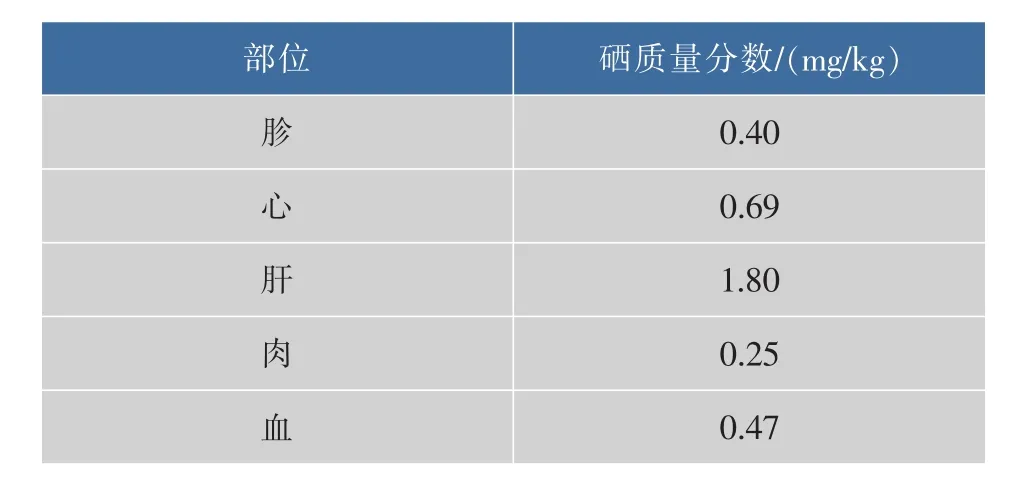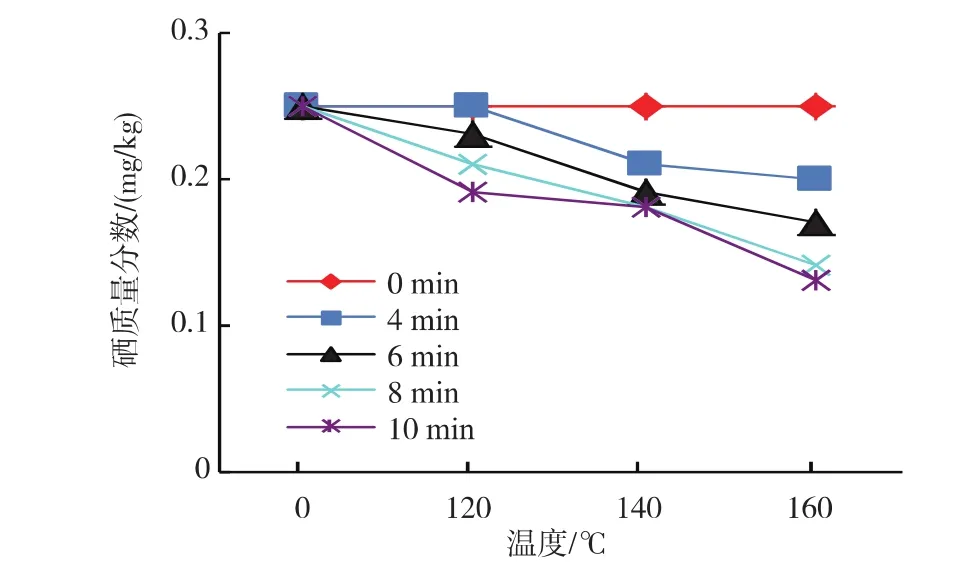厨房加工方法对鸡硒质量分数的影响
2017-09-26缪建芹
缪建芹, 张 慜
(食品科学与技术国家重点实验室,江南大学,江苏 无锡 214122)
厨房加工方法对鸡硒质量分数的影响
缪建芹, 张 慜*
(食品科学与技术国家重点实验室,江南大学,江苏 无锡 214122)
以含无机硒饲料喂养苏禽黄鸡进行硒的富集,并以此为原料,研究常见厨房加工方法烹调鸡含硒部位(肝和肉)工艺,分析4种加工方法对鸡硒质量分数影响的变化及原因。实验结果显示:富硒实验能显著提高鸡体内各部位的硒质量分数;SPSS分析显示,温度差对鸡硒保留率相关性不明显(P>0.05);加工时间对鸡肝、肉相关性显著(P<0.01),且相比于煮制、油炸加工方法,蒸制和烤制加工方式有利于硒在家禽肝、肉质中的保留,是理想的加工方式。
硒;苏禽黄鸡;深加工;保留因子;相关性
作者以含亚硒酸钠(AR)饲料喂养生态养殖的苏禽黄鸡,通过家禽体内吸收使无机硒经其生理代谢转化而富集在鸡体内[10-11],并以此为试验原料,研究了蒸、煮、烤、炸4种厨房加工方法在不同温度、烹制时间烹调鸡的典型含硒部位(肝和肉),研究其硒保留效果,结合Excel、SPSS软件分析了4种厨房加工方法对鸡肝、肉中硒保留率的影响。
1 材料与方法
1.1 试验材料
苏禽黄鸡2号:江苏省家禽科学研究所提供。
1.2 试验方法
选择40日龄鸡150只,以2.5 mg/kg含亚硒酸钠饲料喂食生态养殖的苏禽黄鸡,试验过程中观察记录喂食含硒饲料后鸡的状态,包括食欲、粪便及精神状态[12-13]等。
1.3 样品采集与测定
样品采集:随机抽取5只苏禽黄鸡,取鸡胗、鸡心、鸡肝、鸡胸肉、鸡血等样品,测定硒质量分数。
硒质量分数的测定:依据“食品安全国家标准:食品中硒的测定”(GB5009.93-2010)方法[14-15]。
保留率:硒质量分数保留率以厨房加工前后禽肝或肉硒含量比值,单位为%。
用比较文学的方法来研究鲁迅的作品,由来已久,从最早的上世纪20年代赵景深的影响研究的论文《鲁迅与柴霍夫》算起(注:柴霍夫,现译为契诃夫),迄今已近百年,相关专著和论文已经是汗牛充栋。很早就有学者注意到俄苏文学对鲁迅创作的影响,之后,鲁迅同日本文学、德国文学、英国文学、东欧各国文学之间关联的学术论述也不断出现,对鲁迅的比较文学研究也蔚为大观。
2 结果与分析
2.1 鸡富硒试验
以含硒2.5 mg/kg质量分数饲料喂食鸡,4周后随机抽取鸡样品进行测定,胗硒、心硒、肝硒、肉硒、血硒的测定结果见表1。

表1 富硒鸡不同部位的硒质量分数Table 1 Selenium content of chicken's different apparatus
2.2 厨房加工方法对鸡肝、肉硒质量分数的影响
2.2.1 不同厨房加工方式对鸡肝硒质量分数的影响如图1-4所见,蒸制时间和温度对鸡肝中硒质量分数变化不大,随着温度的升高,硒质量分数保留率越低,呈明显下降趋势;煮制时间和温度对硒保留率影响较明显(P<0.05),如140℃下,8 min煮制硒保留率为58.3%,10 min时降至28.9%;烤制时间的延长和温度的升高变化不大,保留因子在56.1%(160℃、10 min)以上;油炸温度和时间对鸡肝中硒质量分数的变化明显(P<0.05),相同温度下,时间越久,鸡肝中保留因子越低,如140℃下,油炸4 min时保留率为91.2%,6 min为71.1%,8 min为60%,10 min仅为37.8%;但相同时间下,温差变化对鸡肝中硒质量分数变化不明显,如8 min时,保留率为58.9%、60%、56.1%。可见,影响鸡肝中硒质量分数的主要因素是油炸时间,且温度越高,硒质量分数越低。

图1 不同条件蒸制鸡肝中硒质量分数变化Fig.1 Changes of selenium content under different steaming-process conditions in the chicken liver

图2 不同条件煮制鸡肝中硒质量分数变化Fig.2 Changes of selenium content under different cooking-process conditions in the chicken liver

图3 不同条件烤制鸡肝中硒质量分数变化Fig.3 Changes of selenium content under different baking-process conditions in the chicken liver

图4 不同条件油炸鸡肝中硒质量分数变化Fig.4 Changes of selenium content under different frying-process conditions in the chicken liver
4种烹制方式对鸡肝硒含量的有效保留率比较为:蒸制>烤制>油炸>煮制;综合考虑鸡肝加工特性及成熟度因素,鸡肝中硒保留率最佳的工艺为:140℃、4 min蒸制,保留率98.9%;120℃、6 min烤制,保留率达86.7%;160℃、4 min煮制,保留率98.3%和140℃、4 min油炸,保留率91.2%。
2.2.2 不同厨房加工方式对鸡肉硒质量分数的影响图5-8显示,随着蒸制温度的升高、时间的延长,鸡肉中硒质量分数的下降趋势越明显,且温度越高,保留率越低;时间越久,鸡肉中硒质量分数变化较明显,如160℃时,10 min加热时长鸡肉中硒质量分数仅为4 min时的50%。煮制时间越长,加热温度越高,鸡肉中硒质量分数越低,变化越明显 (P<0.05),如10 min时,120、140℃的保留因子为44%、28%,是160℃保留率的7~11倍。烤制方式对鸡肉中硒质量分数的变化不大,保留因子在52%(160℃、10 min)以上,是有效保留鸡肉硒质量分数的方式。油炸温度和时间对鸡肉中硒质量分数的影响明显(P<0.05),相同温度下,时间越久,鸡肉中保留因子越低,如160℃下,油炸4 min时保留因子(80%)是10 min的5倍;但相同时间下,温差变化对鸡肉中硒质量分数变化也明显,如8 min下,120、140、160℃时,鸡肉中硒保留因子逐渐减少,为72%、56%、40%。

图5 不同条件蒸制鸡肉中硒质量分数变化Fig.5 Changes of selenium content under different steaming-process conditions in the chicken meat

图6 不同条件煮制鸡肉中硒质量分数变化Fig.6 Changes of selenium content under different cooking-process conditions in the chicken meat

图7 不同条件烤制鸡肉中硒质量分数变化Fig.7 Changes of selenium content under different baking-process conditions in the chicken meat

图8 不同条件油炸鸡肉中硒质量分数变化Fig.8 Changes of selenium content under different frying-process conditions in the chicken meat
可见,油炸时间和温度对鸡肉中硒质量分数的保留率均影响较大,且时间越久、温度越高,硒质量分数损失越大。4种烹制方式对鸡肉硒质量分数的有效保留率比较为:烤制>蒸制>油炸>煮制。综合考虑鸡肉加工特性及成熟度因素,鸡肉以120℃、4 min蒸制,硒保留率96%;140℃、6 min煮制,保留率76%;160℃、4 min烤制,保留率80%和140℃、6 min油炸,保留率80%。
3 讨论
研究证明,通过在家禽日粮中添加富硒剂实现硒的富集,进而为人群补硒的途径有较好的现实意义[16-17]。本试验中,家禽富硒过程实现了将饲料日粮中的无机形态的Se4+(Na2SeO3)由肠道被动吸收,被还原成硒化物(-2价态),然后转运至肝脏内,有效提高了GSH-Px等酶类的合成与表达,促进硒在细胞内的代谢活动[18-19],合成了具有硒生物功能的硒代蛋氨酸,进一步形成硒蛋白[20-22],成为生物体可利用形式[23],从而提高了硒的人体利用率[24-25]。
在厨房加工时,无论鸡肝、鸡肉,随着烹制时间的延长和温度的升高,蒸、煮、烤、油炸4种方式处理,硒质量分数变化差异明显,以蒸制和烤制对硒质量分数的保留率较为有效,而煮制对硒保留率最低。出现这种情况的原因可能在于,高热蒸汽和高热热辐射对鸡肝(肉)进行加热,减少了水流与材质的直接接触,使硒的损失量相应会减少,但也因为高热水蒸气与鸡肝(肉)接触会产生部分自由水或因过高的热量增加了鸡肝(肉)细胞的结构的不稳定性,会使肝、肉中聚集的少量自由硒随之溶出;而烤制则由于热辐射使鸡肝(肉)细胞中油脂成分溢出,带出部分自由硒,从而使硒含量降低,但变化不明显,大量的硒仍保留在鸡肝中,如蒸制鸡肝,最低有83.4%保留在鸡肝内;烤制鸡肝,最低有56.1%保留在鸡肝内。而煮制和油炸工艺,则将鸡肝直接放置于热水和油脂中加工,随着热量和水分等进入到鸡肝细胞内,破坏了鸡肝细胞组织的稳定性,使得大量的自由硒溶出到水和油脂中。
同时,SPSS相关分析显示,温差对保留率相关关系不明显(P>0.05),但烹制时间对鸡肝、肉相关性显著(P<0.01),相关性指数表现为蒸制鸡肝0.764,鸡肉0.689;烤制鸡肝0.869,鸡肉0.807;煮制鸡肝0.912,鸡肉0.888;油炸鸡肝0.937,鸡肉0.875。煮制和烤制方式对肝和肉的相关性明显高于蒸制和烤制,即煮制和油炸方式对硒保留率影响较大,不利于硒的留存,而蒸制和烤制从加工特性上更有利于硒在家禽肝、肉质中的保留,是理想的加工方式。
4 结语
生态鸡富硒试验以含0.25mg/kg亚硒酸钠饲料喂养开发富硒产品最佳,产品原料中肝硒1.80 mg/kg、肉硒0.25 mg/kg、心硒0.69 mg/kg、胗硒0.40 mg/kg、血硒0.47 mg/kg。在此基础上,以肝和肉为研究对象,以蒸、煮、烤、油炸4种厨房加工方式进行加工,考察加工工艺和硒质量分数保留率,结果为:最佳的烹制条件,鸡肝以140℃、4 min蒸制工艺,硒质量分数保留率98.9%;120℃、6 min烤制工艺,保留率86.7%;160℃、4 min煮制工艺,保留率达98.3%和140℃、4 min油炸工艺,保留率91.2%。鸡肉以120℃、4 min蒸制,硒质量分数保留率96%;140℃、6 min煮制,保留率76%;160℃、4 min烤制,保留率80%和140℃、6 min油炸,保留率80%。综合比较4种厨房加工方式可见,对鸡肝(肉)硒质量分数有效保留较好的方式为蒸制>烤制>油炸>煮制。
[1]NI Jingan.Relationship between trace elements selenium,free radicals and health[J].Journal of Wuxi University of Light Industry,1992(3):274.(in Chinese)
[2]LIU Chunren.Selenium,an essential trace element of biological activity in livestock and poultry[J].China Feed,1996,24:13-15.(in Chinese)
[3]CHEN Yanlin,FAN Yanli.Research progress on the biological function of selenium and Se-enriched foodstuff[J].Journal of Hebei Agricultural Sciences,2008,12(9):99-100,139.(in Chinese)
[4]OUYANG Peizhen.Metabolic characteristics and physiological functions of selenium[J].China Food Additives,1995(1):50-53.(in Chinese)
[5]LU Liming,HUANG Zhijian.Progress of selenium in animal nutrition[J].Animal Science&Veterinary Medicine,2004,21(6):41-42.(in Chinese)
[6]RAYMAN M P.The importance of selenium to human health[J].Lancet,2000,356:233-241.
[7]GUPTA U C,GUPTA S C.Selenium in soil and crops,its deficiencies in livestock and human:implications for management[J]. Commun Soil Sci Plant Anal,2000,31:1791-1807.
[8]KANG Shouting.Research progress of trace element selenium nutrition[J].China Animal Husbandry&Veterinary Medicine,2009,36(1):34-37.(in Chinese)
[9]WHANGER P D.Selenocompounds in plants and animals and their biological significance[J].J Am Coll Nutr,2002,21(3):223-232.
[10]HU Bin,CHEN Yizi,GU Xuedong.Experiment on acute and accumulative toxicity test of selenium reinforcement[J].Journal of Food Science and Biotechnology,2010,29(4):553-557.(in Chinese)
[11]WANG Qinghua,HUANG Wei,LI Qianyong,et al.Application and development of selenium accumulating food in China[J]. Guangdong Trace Elements Science,2008(3):45-46.(in Chinese)
[12]CHEN Bilian.Research status of functional food enriched Zinc and selenium in China[J].Food Research and Development,1999,20(1):33-37.(in Chinese)
[13]WANG Jinghuai,SHI Chenzi.Study on the development of selenium enriched agricultural products and the selenium content standard[J].Science and Technology of Tianjin Agriculture and Forestry,2005(3):15-17.(in Chinese)
[14]GB 5009.93-2010,食品中硒的测定[S].2010.
[15]LIU Yang,ZHANG Tao,YANG Jing,et al.Analysis of selenium specication in the selenzied yeasts by RPLC-ICP-MS[J]. Journal of Food Science and Biotechnology,2013,32(12):1261-1265.(in Chinese)
[16]ZENG Jing,LUO Haiji.Research progress of trace element selenium[J].Studies of Trace Elements and Health,2003,20(2):52-56.(in Chinese)
[17]XIONG Bo,WANG Xinjun.The biochemistry function of selenium nutrition and relation between the exercise and selenium[J]. Journal of Ankang University,2009(2):35-36.(in Chinese)
[18]CHEN Zhongfa,HAN Zejian.Effect of organic selenium added to laying hens diet on egg selenium concentration,egg VE concentrations and egg hangh unit[J].Acta Zoonutrimenta Sinica,2004(16):32.(in Chinese)
[19]LI Yeguo,GUO Feng,LI Tongshu.The Effects of different selenium sources on broiler production performance,meat quality and serum thyroid hormone in different dietary selenium sources[J].Animal Husbandry&Veterinary Medicine,2005(8):30-32.(in Chinese)
[20]CHASSAIGNE H,CHERY C C,BORDIN G,et al Development of new analytical methods for selenium speciation in selenium-enriched yeast material[J].Journal of Chromatography A,2002,976(1-2):409-422.
[21]TAN Zhixin,LI Yushan.Research progress on the antioxidative effect of selenium[J].Modern Preventive Medicine,2003,30(6):87-89.(in Chinese)
[22]YANG Guangqin,GU lvzhen.The human body needs and safety of trace element selenium[J].Progress in Physiological Sciences,1992,23(2):184-186.(in Chinese)
[23]ALLEN K,SOETA C,NAITO K,et al.Expression of myostatin gene in regenerating skeletal muscle of the rat and its localization [J].Biochem Biophys Res Commun,2000,270:510-516.
[24]WANG Zaigui.The problem of selenium nutrition and safety[J].China Animal Husbandry,2002(6):10-11.(in Chinese)
[25]GEESINK G H.Rigor.Temperature and meat quality characteristics of lamb longissimus muscle[J].Animal Science,2000,78(11):2842-2848.
Study on the Effect of the Kitchen Processing Methods on the Selenium Content in the Chicken
MIAO Jianqin, ZHANG Min*
(State Key Laboratory of Food Science and Technology,Jiangnan University,Wuxi 214122,China)
This experiment with inorganic selenium feed feeding Suqin yellow chickens of selenium enrichment,and use it as raw material,study the common processing method of cooking chicken with selenium sites(liver and meat)process,and four processing methods on the influence of selenium content in chicken change and the reason analysis.Experimental results are as follows:Selenium experiment can significantly improve the selenium content of chicken in different parts;SPSS analysis shows that temperature difference of chicken selenium retention rate correlation is not obvious(P>0.05);the processing time of chicken liver,meat phase had significant correlation(P<0.01)and compared to cooking,frying processing methods,steaming and baking processing methods is conducive to the retention of selenium in the liver and meat of poultry,they are the ideal processing methods.
selenium,Suqinyellowchicken,kitchen-processingmethods,retentionfactor,correlation
TS 201.1
:A
:1673—1689(2017)07—0738—05
2015-09-28
国家重点研发计划项目(2017YFD0400501);江苏省“333工程”中青年科学技术带头人项目(SRC20111505);江苏省食品安全快速检测技术研究开发工程中心项目(20106938)。
缪建芹(1980—),女,江苏江阴人,讲师,从事生鲜食品加工与贮藏研究。E-mail:247835005@qq.com
*通信作者:张 慜(1962—),男,浙江平湖人,工学博士,教授,博士研究生导师,主要从事农产品贮藏与加工研究。E-mail:min@jiangnan.edu.cn
缪建芹,张慜.厨房加工方法对鸡硒质量分数的影响[J].食品与生物技术学报,2017,36(07):738-742.
